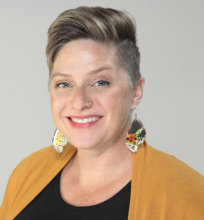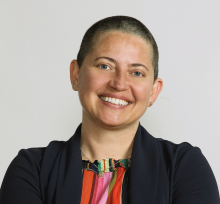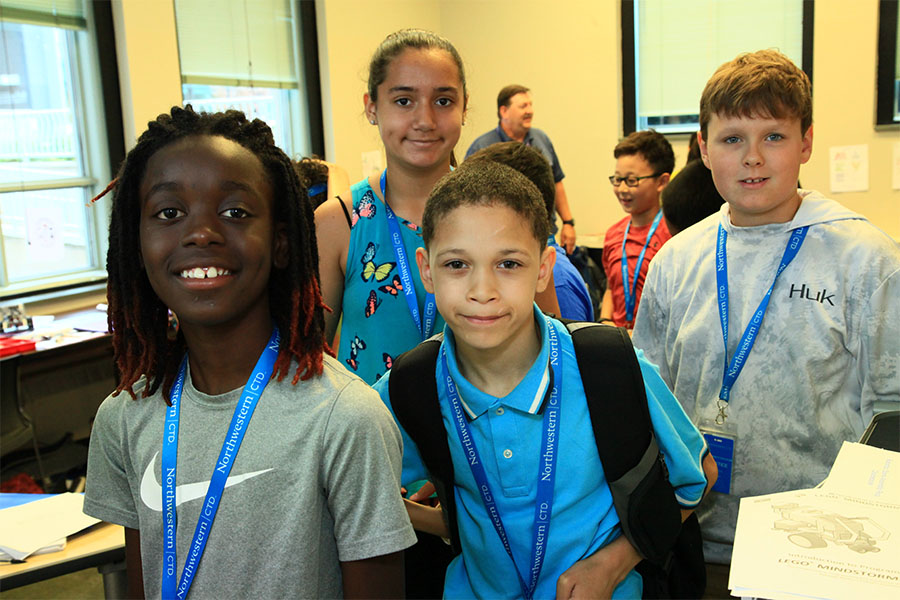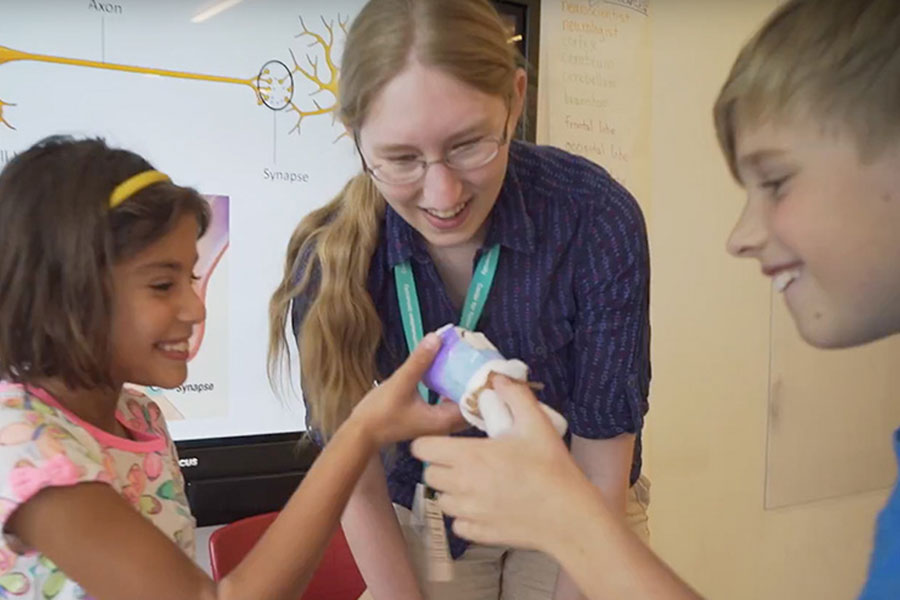Social-Emotional Learning: Inseparable from Academic Rigor
By Ed Finkel
Embedded in both in Center for Talent Development curricula and in presentations CTD researchers provide for academics, parents and the general public is the research-backed assertion that social-emotional learning (SEL), and psychosocial skills more broadly, are a core, intertwined piece of academic rigor—not a frivolous add-on or a nice-to-have, optional puzzle piece of talent development.
In fact, the skills and behaviors involved in SEL help students realize their academic talents because they include managing time and planning, regulating emotions to help achieve one’s goals, developing a healthy self-concept, practicing self-awareness, learning to ask for help when needed, receptiveness to feedback, self-advocacy, and positive risk-taking.
CTD researchers Eric Calvert, associate director; Ruth Doan, coordinator of academic programs; and Nick Kapling, coordinator of advanced enrichment programs, presented their work and viewpoints on this topic both during the 2022 National Association for Gifted Children Annual Convention and a subsequent CTD Backpack for Parents presentation last year.
 “What we’re talking about is increasing academic rigor with social-emotional learning and how to design that,” Kapling says. “Coming out of the pandemic, there was this real sense of tension, or maybe even backlash, from parents about SEL in the classroom. And so we wanted to speak to that and talk about how, in the talent development model, we don’t see SEL as something extra. … It’s actually what makes a lot of our classes kind of difficult, is that we’re allowing students to put themselves in situations where they are having to collaborate with others, share their ideas, and speak up for their own ideas. It’s part of what makes the class rigorous.”
“What we’re talking about is increasing academic rigor with social-emotional learning and how to design that,” Kapling says. “Coming out of the pandemic, there was this real sense of tension, or maybe even backlash, from parents about SEL in the classroom. And so we wanted to speak to that and talk about how, in the talent development model, we don’t see SEL as something extra. … It’s actually what makes a lot of our classes kind of difficult, is that we’re allowing students to put themselves in situations where they are having to collaborate with others, share their ideas, and speak up for their own ideas. It’s part of what makes the class rigorous.”
Another key point that emerged from CTD’s research is that social-emotional competencies are a domain of talent in and of themselves, Doan notes. “When we think about the talent development model that goes from these kinds of exploratory, novice skills and leads into competency, which leads into expertise and even eminence, we can think about SEL on that same trajectory,” Kapling says. That means, like developing academic talent, “It’s not necessarily a light-switch, or a ‘you have it or you don’t’ giftedness,” she adds. “You have a skill for something, which means you can develop it, which means you can get better at it.” So a skill like accepting mistakes as essential to learning can be developed over time.
Domains of talent like science, music or athletics are not just static canons of knowledge, but rather also incorporate and draw from living, dynamic social networks of people, Doan says. ‘Social emotional skills actually allow individuals who are working to progress within a domain,” she says. “It’s like a force-multiplier.”
To reach the top level of any domain requires building SEL skills because you don’t reach that summit alone, Kapling says. “And once you’re there, you don’t stand in a silo,” she says. “You’re going to be leading, or working, or collaborating with other people—and if you don’t know how to work, facilitate or collaborate with other people, you are at a disadvantage.”
 Part of the fixed-trait mindset within the gifted community that preceded the advent of the talent development model was the erroneous notion that one way gifted children can be identified is via universal social-emotional traits such as asynchronicity and over-excitability, Doan says. “That is also not helpful when it comes to supporting the individual needs of the gifted student,” she says, noting that recent research shows weak connections between giftedness and these traits—and that, in any case, those who have them tend to grow out of them.
Part of the fixed-trait mindset within the gifted community that preceded the advent of the talent development model was the erroneous notion that one way gifted children can be identified is via universal social-emotional traits such as asynchronicity and over-excitability, Doan says. “That is also not helpful when it comes to supporting the individual needs of the gifted student,” she says, noting that recent research shows weak connections between giftedness and these traits—and that, in any case, those who have them tend to grow out of them.
Kapling adds that this mindset can reinforce negative stereotypes and tamp down students’ growth potential. “Because they’re going to think, ‘Oh well, I tried this one time, and I wasn’t a master at it, so I guess I’m never going to be good at it,’” she says. “What we want them to do is be gritty, and try again, and fail in interesting ways, and learn from their mistakes.” Crucial to that, she adds, is teachers understanding that a student who doesn’t immediately excel at a certain skill could do so with time and effort in a context aligned to their level of readiness and ability.
How SEL is Embedded at CTD
CTD infuses social-emotional learning not only in its coursework but through the summer residential experience, Kapling says. “The whole experience of camp is growing their psychosocial skills,” she says, adding that during the presentation to parents, one asked how to know which CTD courses emphasize SEL skills. “My answer was, all of them—100% of our classes—utilize, allow for and encourage social-emotional development. It’s part of what it means to be a CTD class.”
Doan notes that SEL is part of CTD’s Framework for Success, along with academic achievement and behavior, academic persistence and learning strategies. Within the interpersonal and social skills piece of that framework are four subdomains: meaningful interactions with others, respect for diversity, communication and empathy. Inherent in all of this is the notion that SEL advances educational equity and excellence through authentic school-family-community partnerships. “Our Framework for Success is the foundation of how we think about what our programs are for, but also how we evaluate student success,” she says.
At CTD, supporting SEL has meant leaning into what Kapling terms “brutal (real life) feedback” from not only instructors but fellow students. For example, in a debate class, students are talking about hot-button ideas, which lends itself to a naturally competitive environment. Teachers need to be aware of this and “understand that their students are going to need a chance to cope with that competition, and help them grow, both as somebody who was recognized as maybe winning the competition, and somebody who was recognized as maybe not winning,” she says.
In a hands-on, lab-based, design-thinking class, like chemistry, engineering or robotics, this feedback comes not from a debate about ideas but a demonstration of how a students’ creation flies—sometimes literally. “The students are going to create this thing and see feedback without the teacher taking their paper and writing really thoughtful comments on it and handing it back three days later,” Kapling says. “They’re going to get that feedback straight from the world: ‘The code worked; the code didn’t. The robot picked up the cup; the robot didn’t pick up the cup. The rocket flew and broke, or it flew, or it broke.’ ”
Instructors can observe that feedback and help students handle it with perseverance and self-advocacy, Kapling says. “And so again, it’s underlining this idea that the class itself doesn’t have to be focused on SEL in order for the students to get the benefit, and get the opportunity to use it,” she says. “So it’s really just about understanding, for instructors, when you can emphasize reflection to get more out of your students—and to have more learning and better learning.”
Doan and Kapling encourage those who would like to learn more about current thinking around psychosocial skills and social-emotional learning to tap into the resources of the Consortium of Academic Social Emotional Learning (CASEL), which CTD has leaned on as well in building its approach.

